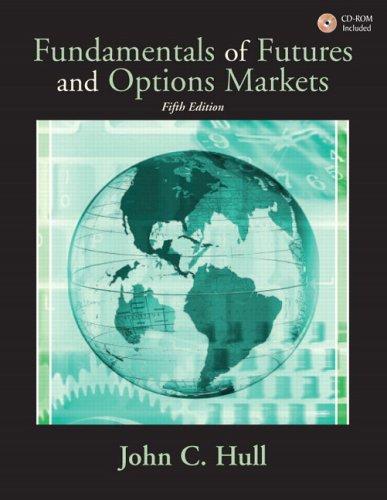Question
B. MULTIPLE CHOICE QUESTIONS For each question, enter the letter of the best response on the blank preceding the question. _C_____ 16. Each of the
B. MULTIPLE CHOICE QUESTIONS
For each question, enter the letter of the best response on the blank preceding the question.
_C_____ 16. Each of the following phrases could be used to describe a capital expenditure EXCEPT
A. a capital expenditure is an outlay made for the earning assets of the firm.
B. a capital expenditure is expected to produce benefits over a period of time greater than
one year.
C. a capital expenditure is an outlay for Current Asset expansion (i.e., perhaps for
an increase in Inventory or Accounts Receivable).
D. a capital expenditure is commonly used to expand the level of the firms operations.
_B_____ 17. Projects that compete with one another, so that the acceptance of one project eliminates
the other projects from further consideration are called
A. independent projects.
B. mutually exclusive projects.
C. replacement projects.
D. none of the above.
______ 18. The ordering of capital expenditure projects on the basis of some pre-determined measure, such as
the rate of return, is called
A. the ranking approach.
B. the independent investment.
C. the accept reject approach.
D. a mutually exclusive investment.
_C_____ 19. Each of the following is a weakness of the payback period method EXCEPT
A. the payback period disregards the cash flows that occur after the payback period.
B. the payback period does not explicitly consider the time value of money.
C. it is difficult to identify the appropriate maximum acceptable payback period.
D. the payback period uses cash flows, rather than accounting profits.
_B_____ 20. The ______________________ is the compound annual rate of return that the firm will earn if it
invests in a capital budgeting project and receives the estimated cash inflows.
A. discount rate
B. Internal Rate of Return (IRR)
C. opportunity cost
D. Weighted Average Cost of Capital (WACC)
_C_____ 21. When the Net Present Value (NPV) is negative, the Internal Rate of Return (IRR) is
_________________________ the Weighted Average Cost of Capital (WACC).
A. greater than
B. greater than or equal to
C. less than
D. equal to
_B_____ 22. ____________________ projects do not compete with each other; the acceptance of one
___________ the others from consideration.
A. Capital; eliminates
B. Independent; does not eliminate
C. Mutually exclusive; eliminates
D. Replacement; does not eliminate
_A_____ 23. Which of the following capital budgeting techniques ignores the time value of money?
A. the payback period
B. Net Present Value (NPV)
C. Internal Rate of Return (IRR)
D. Weighted Average Cost of Capital (WACC)
_D_____ 24. The four basic sources of long-term funds for the business firm are
A. current liabilities, long-term debt, common stock, and preferred stock.
B. current liabilities, long-term debt, common stock, and retained earnings.
C. long-term debt, paid-in capital in excess of par, common stock, and commercial paper.
D. long-term debt, common stock, preferred stock, and retained earnings.
_A_____ 25. Generally, the order of cost from least expensive to the most expensive, for long-term
capital of a corporation is
A. long-term debt, preferred stock, retained earnings, new common stock.
B. common stock, preferred stock, long-term debt, short-term debt.
C. new common stock, retained earnings, preferred stock, long-term debt.
D. preferred stock, long-term debt, retained earnings, common stock.
_C_____ 26. A firm has determined its cost of each source of capital and its optimal capital structure, which is
composed of the following sources and target market value proportions:
| Source of Capital | Target Market Proportions: | After-Tax Cost |
| Long-Term Debt | 45% | 5% |
| Preferred Stock | 10% | 14% |
| Common Stock Equity | 45% | 22% |
If the firm were to shift toward a more leveraged capital structure (i.e., a greater percentage of
debt in the capital structure), the weighted average cost of capital would
A. increase.
B. remain unchanged.
C. decrease.
D. not be able to be determined.
_C_____ 27. The firms __________________ is the level of sales necessary to cover all operating costs.
I.e., this is the point at which Earnings Before Interest and Taxes (EBIT) is equal to $0.
A. cash breakeven point
B. financial breakeven point
C. operating breakeven point
D. total breakeven point.
_A_____ 28. If a firms selling price per unit decreases, the firms operating breakeven point will
A. decrease.
B. increase.
C. remain unchanged.
D. change in an undetermined direction.
______ 29. Fixed costs are a function of ______________, not sales, and are typically contractual.
A. EBIT
B. variable cost.
C. time
D. marginal cost
_D_____ 30. If a firms fixed operating costs increase, the firms operating breakeven point will
A. increase.
B. not be affected.
C. decrease.
D. remain unchanged.
Step by Step Solution
There are 3 Steps involved in it
Step: 1

Get Instant Access to Expert-Tailored Solutions
See step-by-step solutions with expert insights and AI powered tools for academic success
Step: 2

Step: 3

Ace Your Homework with AI
Get the answers you need in no time with our AI-driven, step-by-step assistance
Get Started


